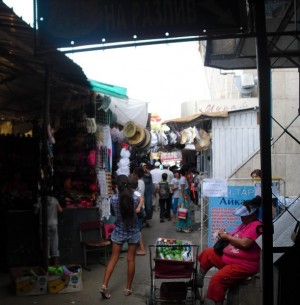24 hours in Bishkek
Suddenly, I found myself stumbling almost head over heels down a short flight of uneven stone steps and into an open room. Conversation peppered the air as it battled against the buzz of electric fans whirring overhead, precariously close to plain light bulbs dangling by thick cords that swayed ever so slightly in the artificially created breeze. Families, couples, friends and others sat around a dozen different tables, laughing and joking as two different women in modest dresses kept disappearing in and out of a small doorway at the far end of the room — finally, a restaurant.
Sitting down at the only open table, a small laminated menu, crusty with heavy use, was handed to me by a smiling waitress. Kyrgyz is one of the world’s oldest spoken languages, but one of its youngest in written form. The old Arabic alphabet and Turkic runes were replaced by the Soviets with the Cyrillic alphabet in 1940, which has remained to this day. But with only the most basic understanding of written Russian, this was…well, as indecipherable as a language can get.
Using my imagination to decide what a dish would taste like based on its blurry monochrome picture, my instincts proved correct when a steaming plate of nan and lamb dumplings known as manti was placed before me. Carried across Central Asia by the Mongols during the 13th and 14th centuries, manti is one of the most popular Kyrgyz dishes, a sort of everyman’s food due to its low cost and relatively simple preparation. On the surface it may appear similar to the popular Georgian stuffed dumplings known as khinkali, but for one important difference: whereas khinkali are filled with copious amounts of juice like a water balloon, manti are as dry as the Kyrgyz terrain itself. That was fine with me, as the fizzy apple-tasting drink I was given to wash it down with proved the perfect liquid complement. The bill for all this, amid an atmosphere one can only find buried in a nameless hole-in-the-wall establishment tucked inside a bazaar: just 110 som ($2.25). A bargain if there ever was one.
Stomach finally full and feeling like I’d sat and people-watched long enough, I ascended the stairs and returned to the bustle of the bazaar. Right, right, left, right, left. Somehow I managed to emerge from the semidarkness and out onto the main roadways of Kiev Street and B. Beishenalieva Street to catch a marshrutka minibus for 20 som (40 cents) to the other side of the city. Decades of Soviet rule have meant that much of the architectural landscape of Bishkek is decidedly Stalinist in flavor. One of the finest examples is Ala-Too Square, the massive public square directly in the city center. Built in 1984 to celebrate the 60th anniversary of what was then the Kyrgyz SSR, the square — which was the site of massive protests in 2005 that culminated in demonstrators storming the official residence of Kyrgyzstan’s first president Askar Akayev, forcing him to flee the country and resign from office — used to be dominated by a gargantuan statue of Vladimir Lenin directly at its center, replaced in 2003 by a new statue called Erkindik (“Freedom”) celebrating Kyrgyz liberation. Despite the changes to its centerpiece, the edges of the square still boast the distinctive grid pattern and box-like simplicity that forms the basis of classical Soviet architecture, a similarity that quickly calls to mind places as diverse as Tbilisi, Georgia or the North Korean capital of Pyongyang. It was a fair sight — one taken in all the more pleasurably whilst sipping a fresh-brewed iced latte (140 som; $2.87) and listening to an eclectic soundtrack ranging from Katy Perry to Alice Cooper from the wraparound balcony at nearby eatery Masal — but by no means my final destination.
The Kyrgyz have been nomads since time immemorial, following their flocks to pasture lands as the seasons change and living in portable round yurts. Although most now live in fixed abodes and even nomads come down from the mountains in winter, they still welcome guests as warmly as they did in the days when visitors were the only source of news from the outside world. The aptly named Nomad’s Home is a continuation of that tradition.
Located on Bishkek’s quieter east side in a residential neighborhood behind the East Bus Station at Drevesnaya 10, Nomad’s Home offers a lodging experience as authentic as any that can be found in Kyrgyzstan. Run by a cheery family with a knack for remembering names and faces despite the large number of people that come and go (more on that in a minute), more than 30 beds are available in a variety of accommodations: hostel-style dorm bunks, private rooms, and, of course, the ubiquitous yurt.
But I wasn’t the only desert wanderer or mountain trekker in town, I soon realized, and the plethora of travelers that pass through Bishkek on their own Silk Road journeys can pitch their tents in the backyard for the night before moving on. They, too, had discovered the understated charm of the mysterious capital of an even more mysterious nation. After a long day of exploring, sharing conversations and drinking copious amounts of tea with my new friends — which included a loyal Manchester City football fan riding a bicycle from London to South Korea, a group of Germans on their way to India, and some Russians who had just returned from visiting Kyrgyzstan’s popular lakeside region of Issyk-Kul — under the clear night sky flecked with stars as numerous as grains of sand on a beach, while the homely scent of blooming flowers and baking bread swirled about, proved to be just the mellow yin to the bustling yang that my day began with. Temperatures still in the high 60s (about 20 Celsius) as midnight rolled around, the door remained open as we slept.


